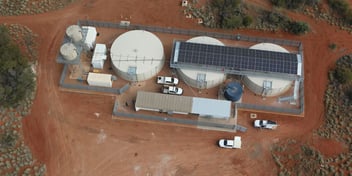Rock holes and cultural water: The importance of Indigenous water management
World Water Day, celebrated on 22 March, provides an opportunity to raise awareness about the importance of freshwater and its sustainable management. The World Water Day theme for 2019 is 'Leaving no one behind'.
In many cases, marginalised groups including Indigenous communities are often overlooked in appropriate access to and management of water.
In the far west of South Australia (SA) and throughout the Anangu Pitjantjatjara Yankunytjatjara (APY) Lands, where water is very scarce, rock holes are an important source of water both from an environmental and an Aboriginal cultural perspective.
The Australian Water Association’s SA branch investigated the importance of rock holes and the cultural significance of these waters to the remote Aboriginal communities in this region.
The importance of rock holes
Rock holes form on granite outcrops and act as natural water collection points for surface drainage. As a semi-reliable water source, rock holes played a significant role in the history and movement of people across the region.
Before the arrival of Europeans, Aboriginal people travelled across the landscape in accordance with the seasons and the availability of water. As such, knowledge of rock hole locations was crucial to survival.
They were also important gathering places where Aboriginal people socialised, traded and performed ceremonies to share traditional lore and Tjukurpa (Pitjantjatjara: relates to the period when ancestral beings created the world).
 As a driving force behind the ongoing care of rock holes around Mimili Community, Lorna Dodd respects cultural traditions with a “no men allowed sign”.
As a driving force behind the ongoing care of rock holes around Mimili Community, Lorna Dodd respects cultural traditions with a “no men allowed sign”.
Today, the presence of large feral animals such as camels, donkeys and horses significantly impacts on the quality and quantity of water in rock holes.
These large animals are ill-equipped to reach the water when levels drop and often die in the attempt, polluting the area with rotting carcasses. When the water is accessible they drink large volumes that would otherwise be available to native species, and also present health risks for Aboriginal people who visit the rock holes.
Caring for country
For Aboriginal people, caring for country is an important cultural obligation. Many rock holes have particular cultural significance to women.
At Mimili, a community in the APY Lands, a program has been developed to support local women to care for important rock holes in the area, including Kalpi, Katapitura, Tipa and Katapitura rock holes.
This involves: digging out and removing debris accumulated in the base of the rock holes to maximise capacity and ensure the water collected is clean; removing invasive weeds and pest animals from around rock holes; and monitoring species that rely on the sites for land management purposes.
Where appropriate and feasible, rock holes are sometimes covered to prevent large feral animals from fouling the water while allowing smaller native species such as kangaroos, dingoes, reptiles and birds to access the water.
This work helps share traditional knowledge and cultural obligations from generation to generation, as well as ensuring the sustainable use of the rock holes.
To celebrate World Water Day 2019, the Water Industry Alliance and Australian Water Association (AW) are hosting a water industry breakfast in Adelaide.
AWA’s National Water Professional of the Year Ciara Sterling will be speaking, as will a representative from the Ngarrindjeri Regional Authority, who will discuss the cultural use of water in the Coorong area of SA. You can register for the breakfast here.
Images and information courtesy of the Alinytjara Wilurara Natural Resources Management Board.

